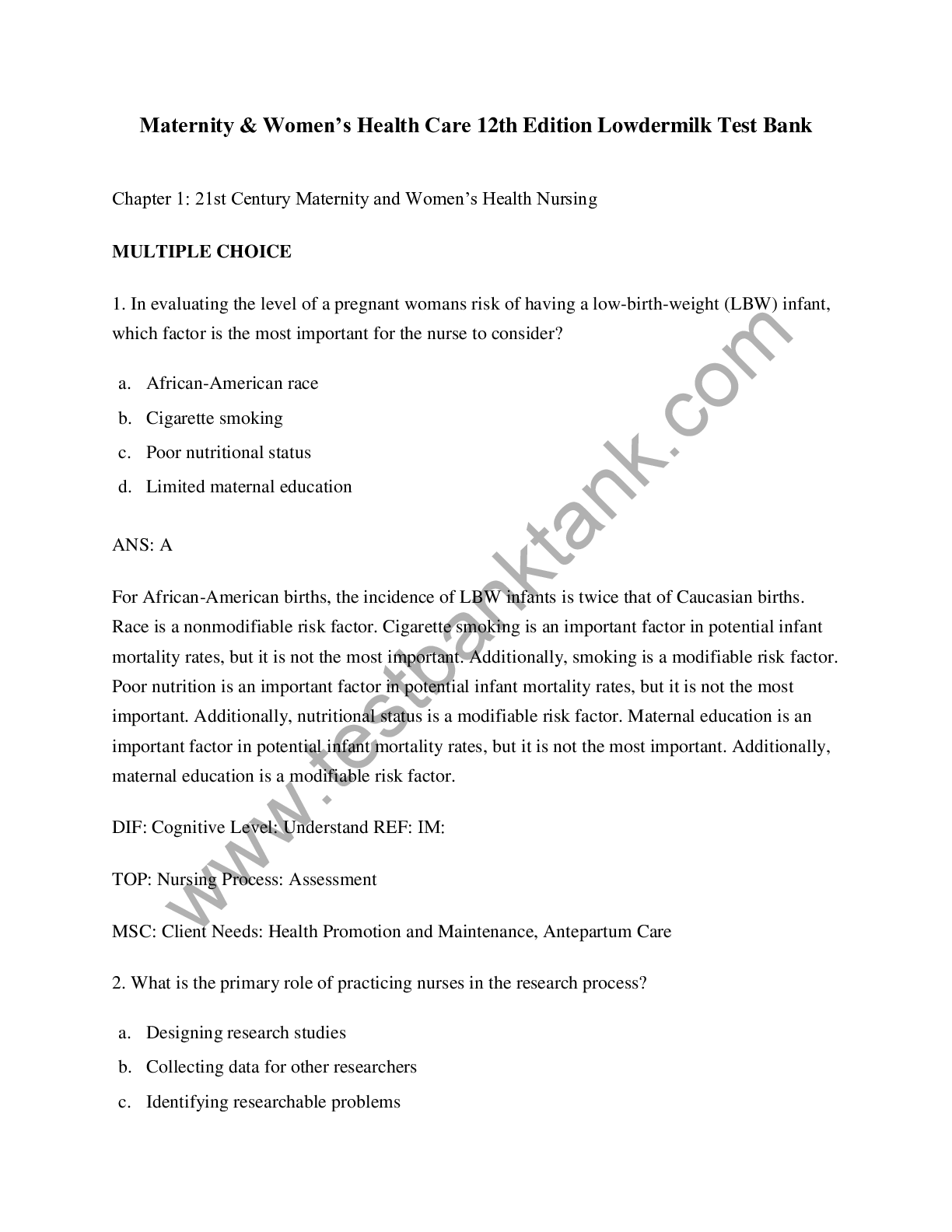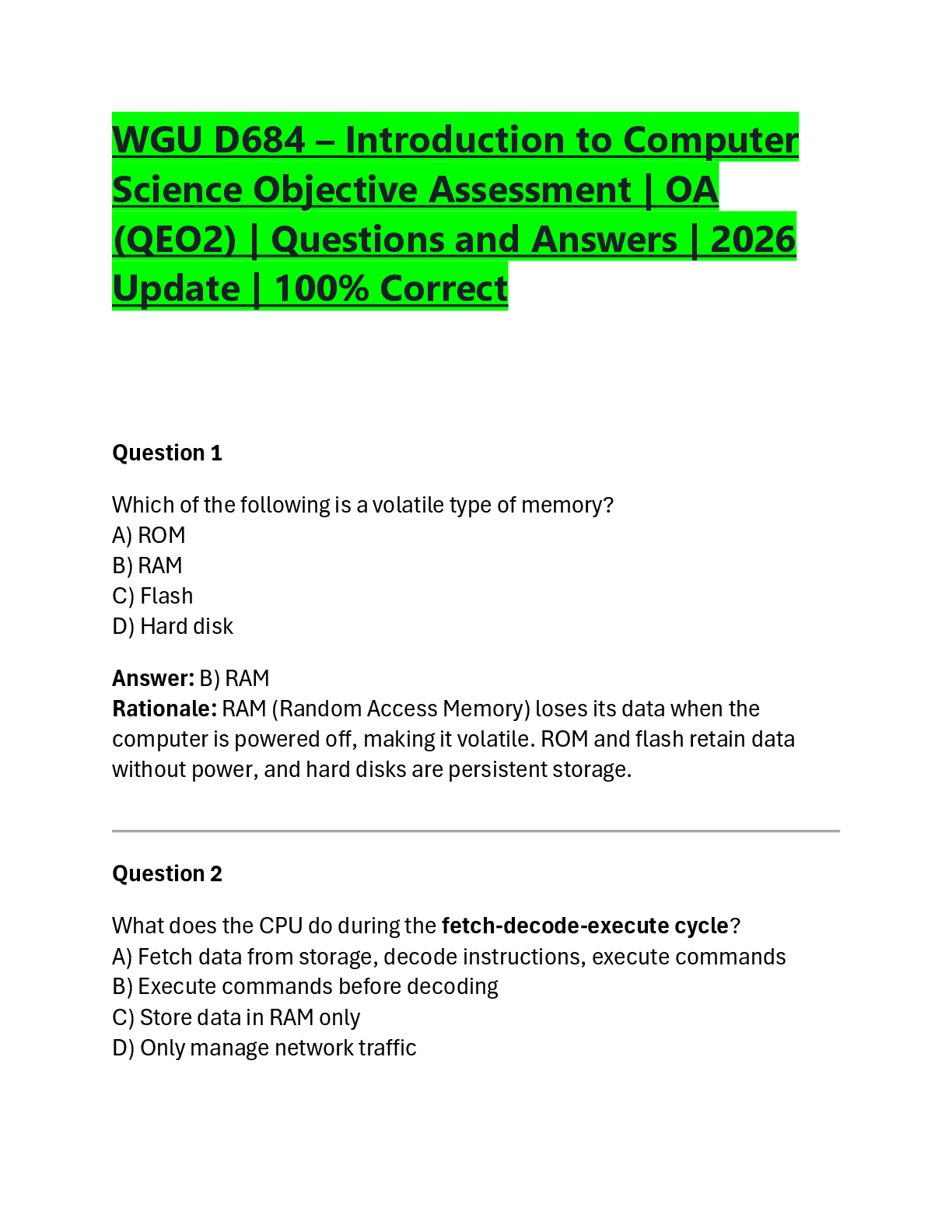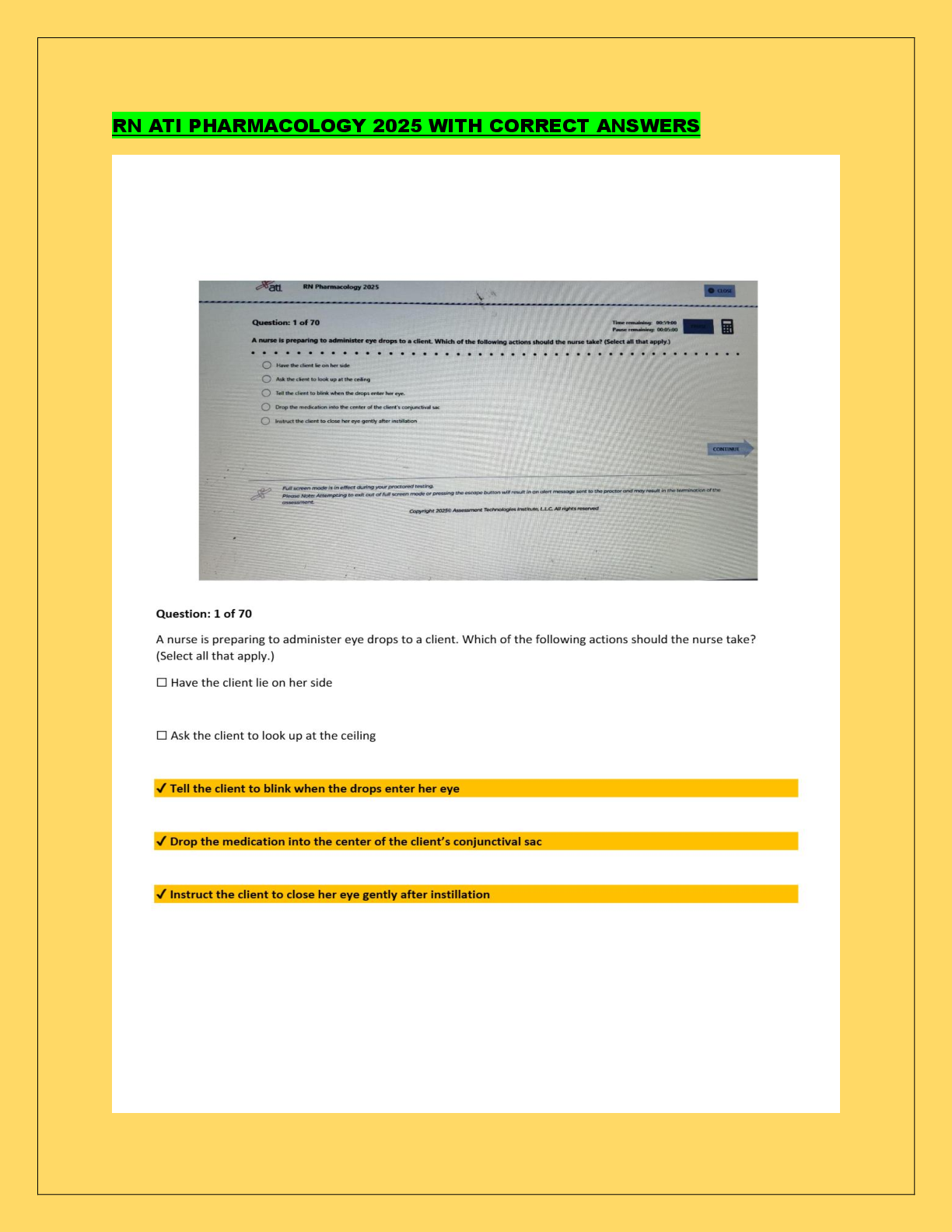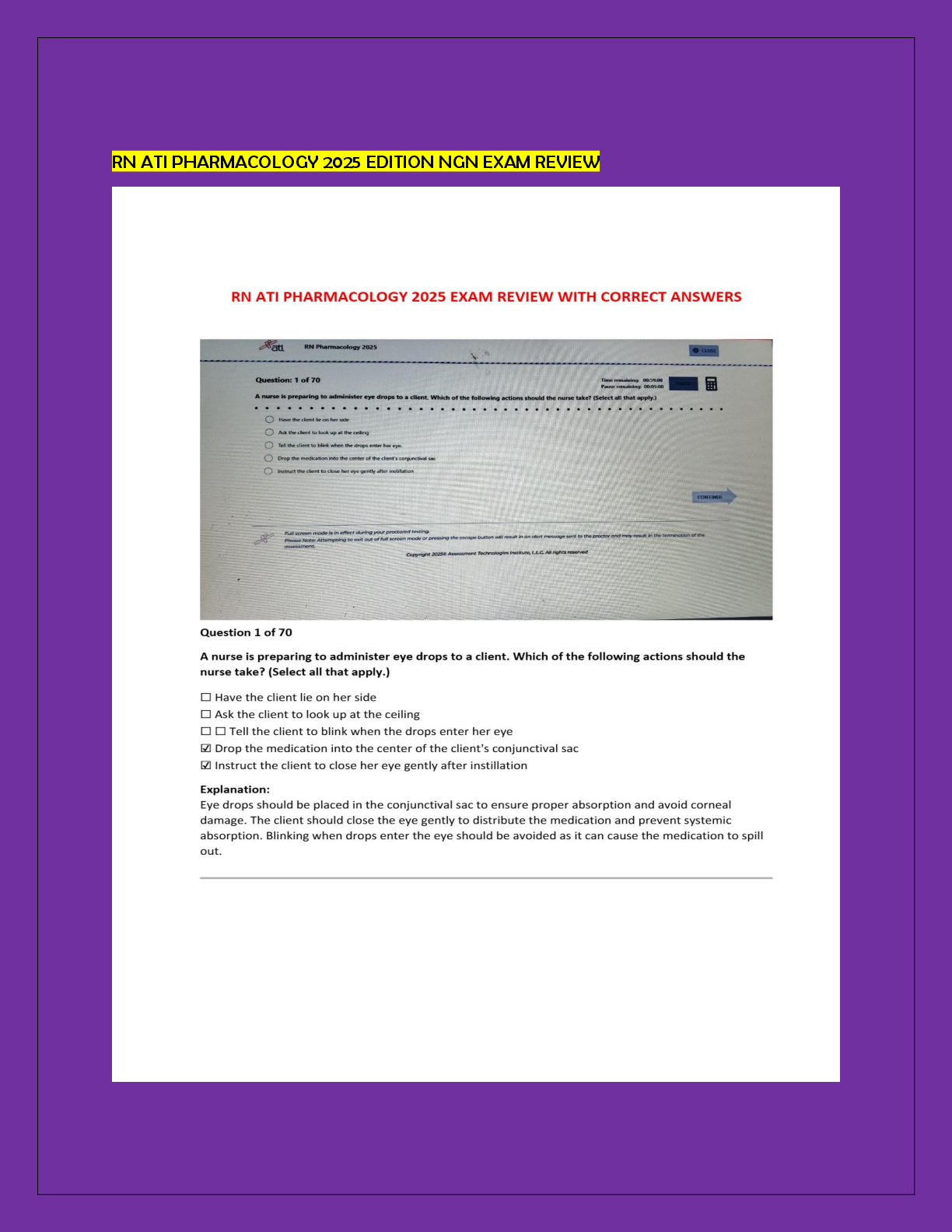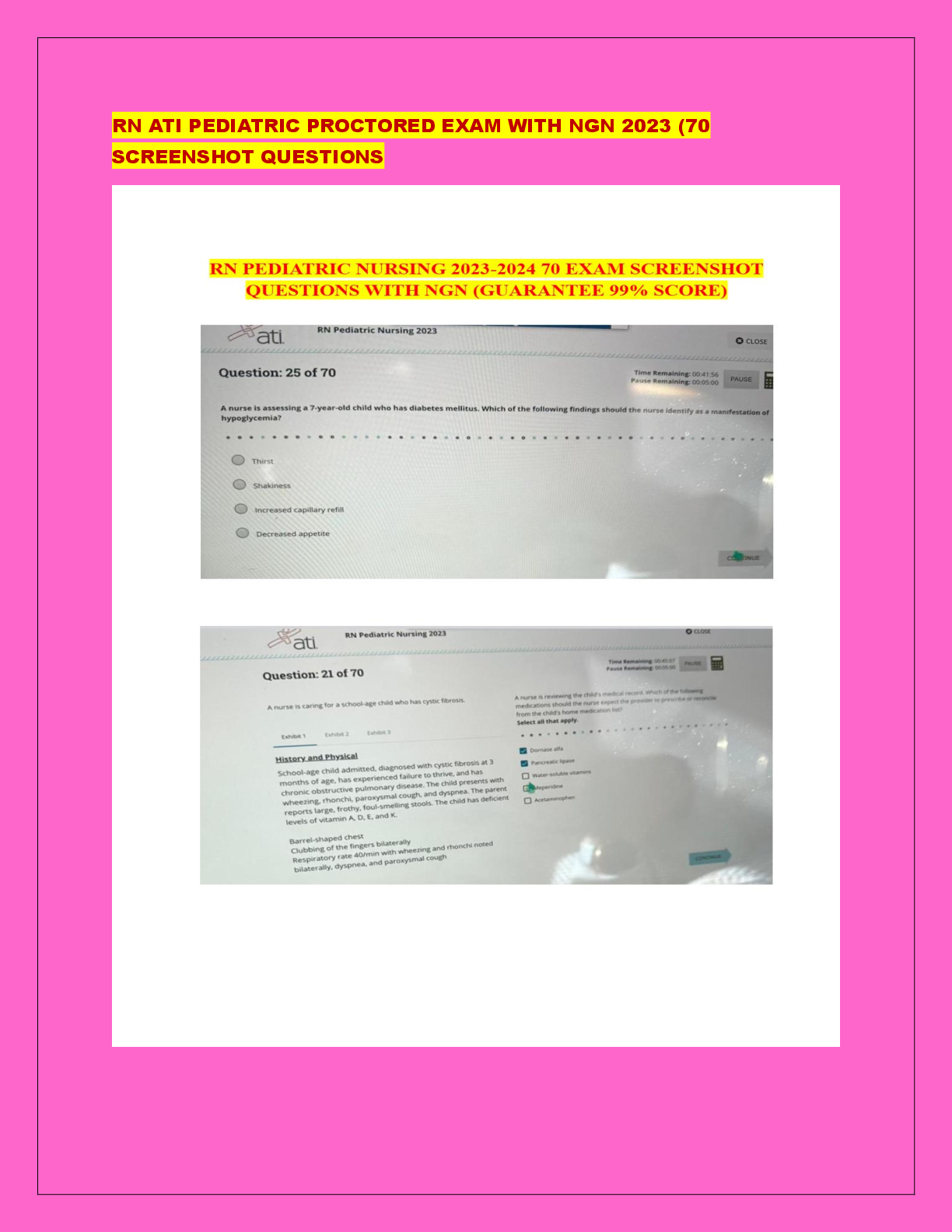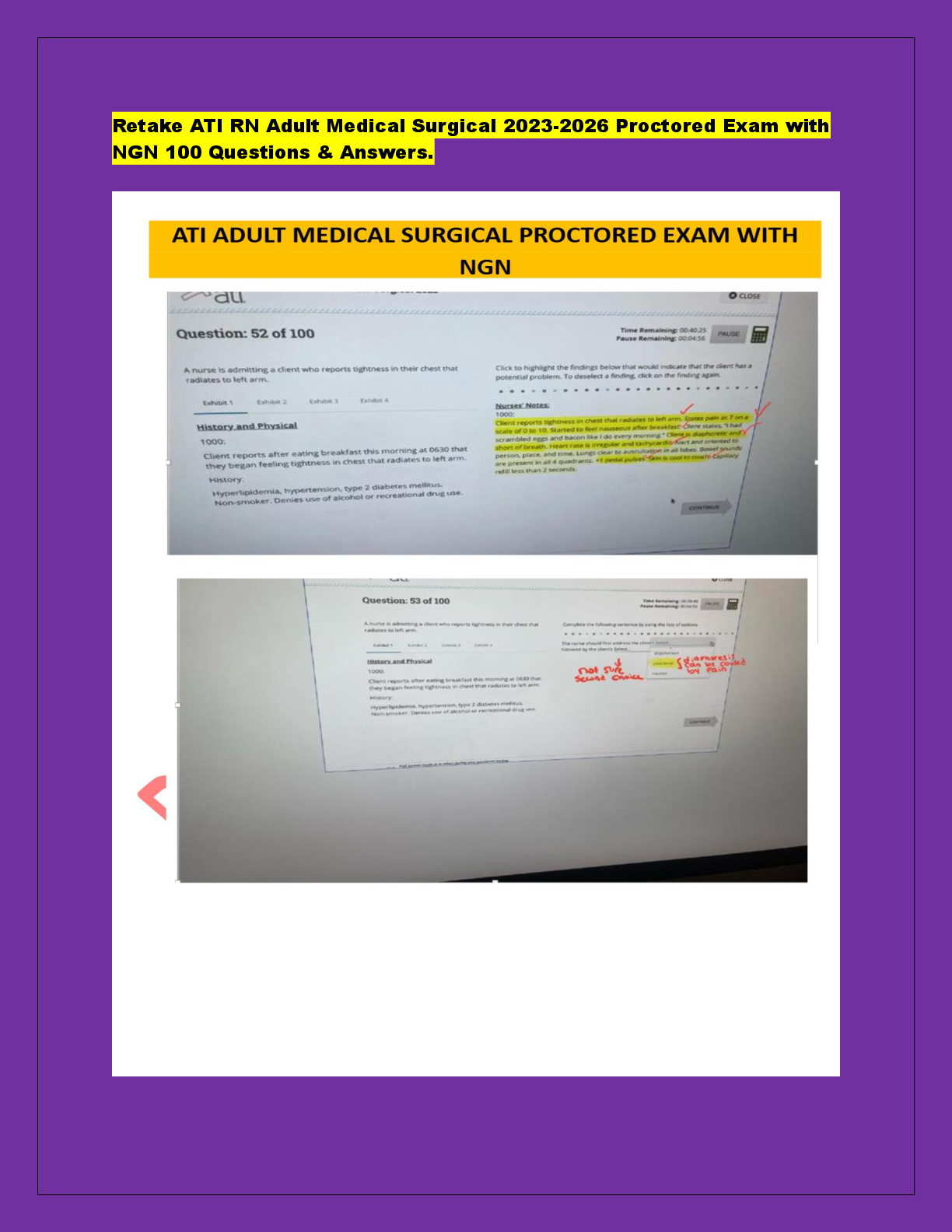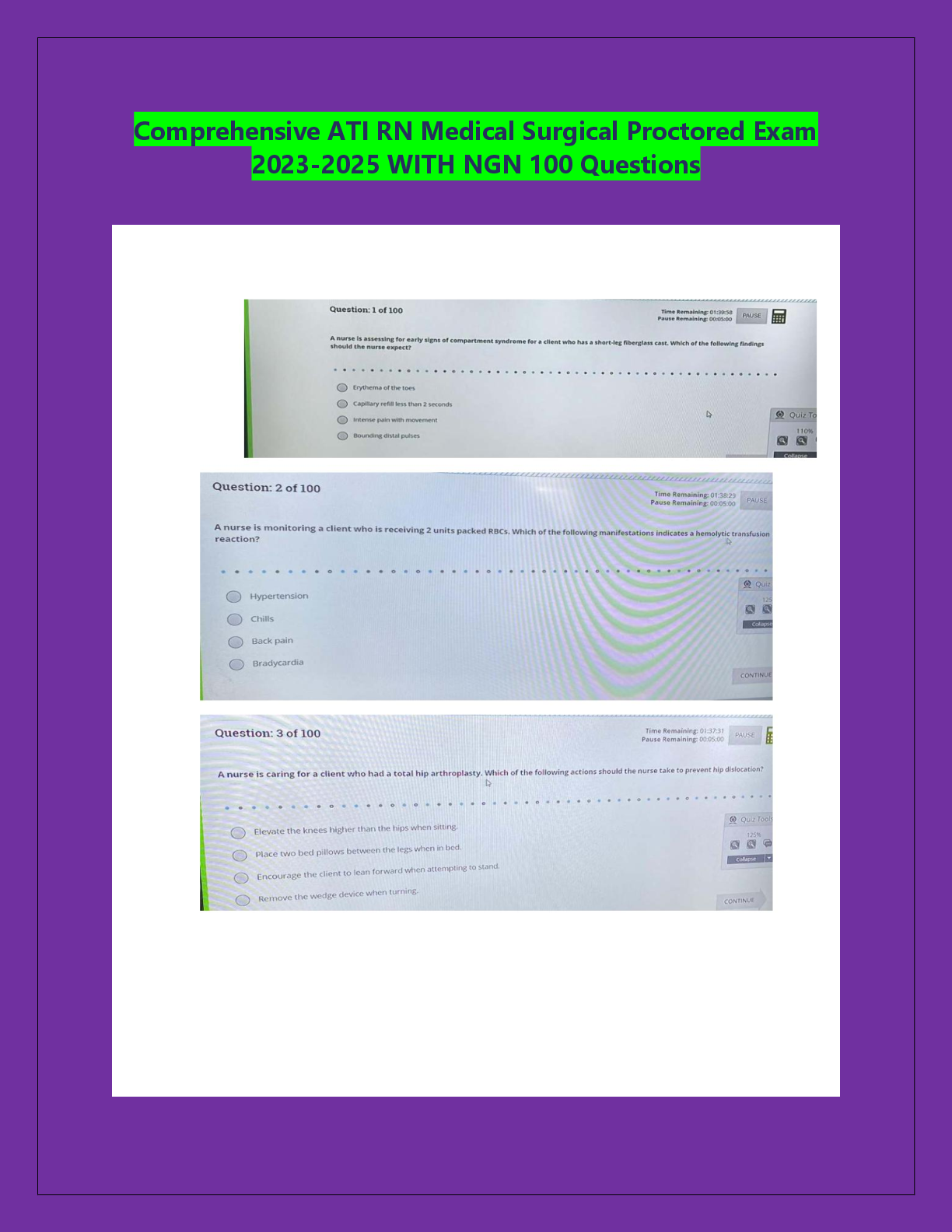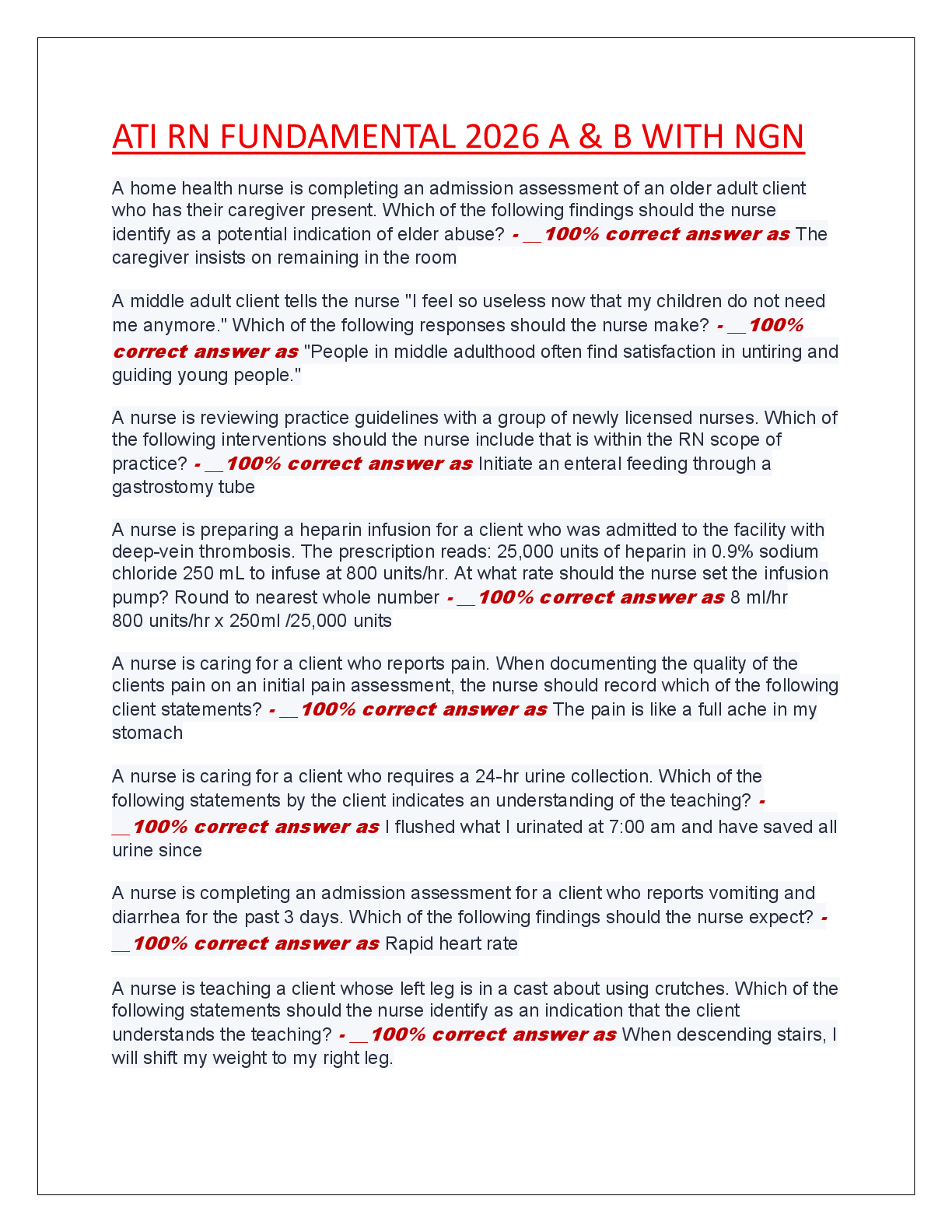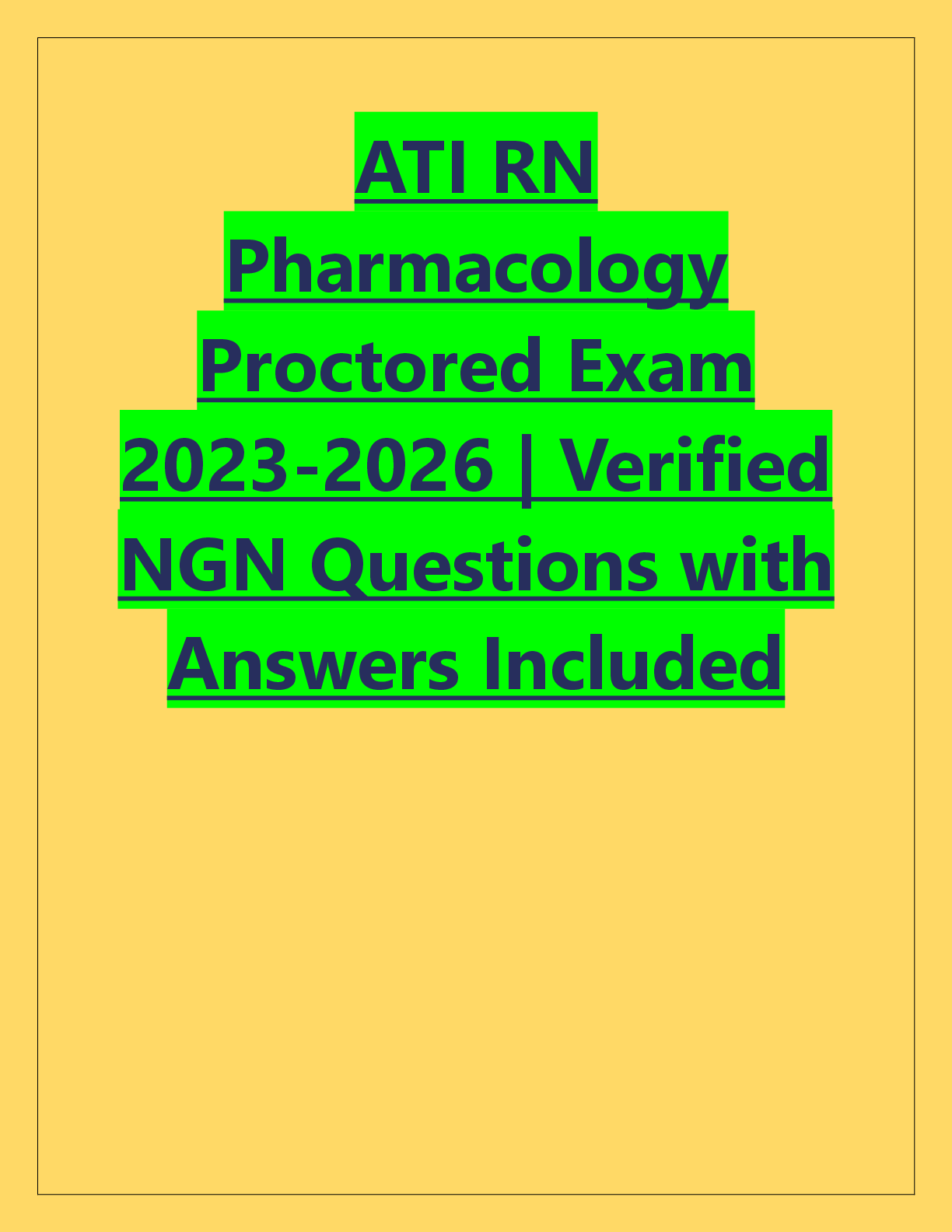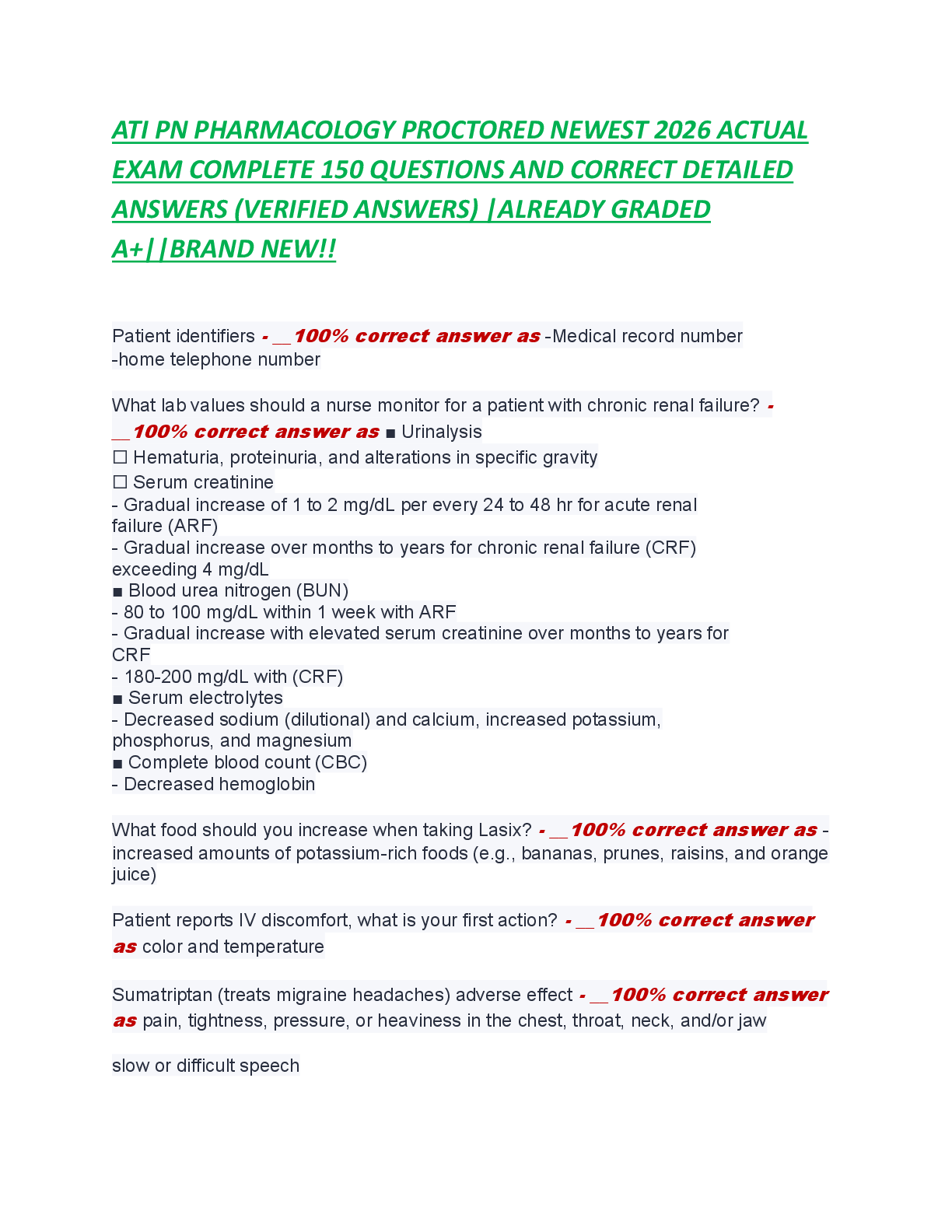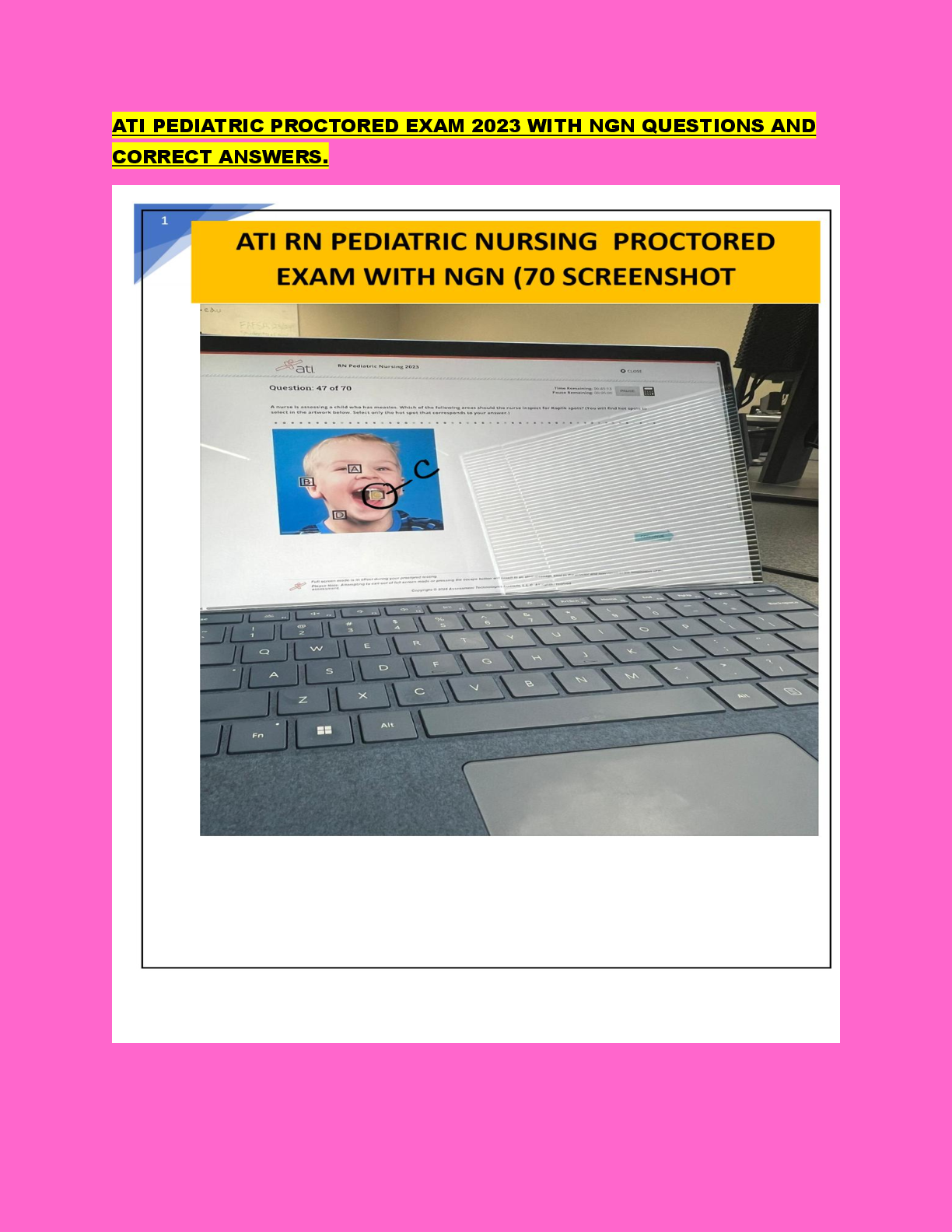*NURSING > ATI > ATI Comprehensive Final Quiz, RN Comprehensive Predictor 2019 A, RN Comprehensive Predictor 2019 For (All)
ATI Comprehensive Final Quiz, RN Comprehensive Predictor 2019 A, RN Comprehensive Predictor 2019 Form B and C
Document Content and Description Below
ATI Comprehensive Final Quiz, RN Comprehensive Predictor 2019 A, RN Comprehensive Predictor 2019 Form B and C What is a nurses priority action when a patient is experiencing anaphylactic shock while ... receiving IV medications? -Answer- Priority action: stop the medication infusion The nurse can also: Administer epinephrine; infuse .9% sodium chloride, and elevate the lower extremities to help maintain adequate blood pressure A nurse is caring for a group of clients in a long-term facility. One of the clients is walking in the hallway and bumping into walls and does not respond to his name. which of the following actions should the nurse take first? -Answer- Accompany the client back to his room. What medication is contra indicated while taking St. John's wort? And why? -AnswerSertraline Taking concurrently puts the patient at risk for serotonin syndrome Both of these are used for Tx of depression Persistent otitis media -Answer- An infection of the middle ear Passive smoking promote adherence of respiratory pathogen's to the lining of the middle ear space which prolongs inflammation and impedes drainage from the ear Exposure to cold weather does not cause otitis media Acarbose (Precose) adverse effects -Answer- Sleepiness, headaches, anemia; the most common adverse effects are gastrointestinal - diarrhea, abdominal distention, cramping, flatulence presbyopia -Answer- impaired vision as a result of aging Can affect one's ability to read the newspaper, the lens is unable to change shape to focus on close up objects Myelomeningocele -Answer- Most severe form of spina bifida in which the spinal cord and meninges are in a cerebrospinal fluid-filled sac and protrude through the spine Neural tube defect pts are at Rx for latex allergy Most common complication of this disorder is UTIPrevention of the development of amblyopia -Answer- A disorder of the eye and which unilateral central blindness occurs as a result of another problem, such as strabismus Parents should patch the unaffected I Strabismus -Answer- Cross eyed Without treatment by 6 years of age this can lead to central blindness (amblyopia) Ethambutol (Myambutol) -Answer- Med for TB, report vision changes immediately Adverse effects: loss of red/green color discrimination due to optic neuritis; d/c if this occurs Isoniazid (INH) -Answer- Antitubercular Adverse effects: hepatotoxicity, peripheral neuropathy, yellowing of the sclera is an indication of jaundice that accompanies liver failure Rifampin (Rifadin) -Answer- Anti TB and Antibiotic Adverse effects: changes in color of bodily secretions to red-orange What is a patient at risk for when they're platelet count is below the reference range? - Answer- Indicates thrombocytopenia, which puts the patient at increased risk for bleeding What should a nurse anticipate with bladder distention in the fourth stage of labor? - Answer- Bladder will fluctuate with palpation Bladder is dull to percussion Uterus will be displaced to the right, is boggy, well above the umbilicus cystitis -Answer- inflammation of the bladder lining, Commonly occurs with UTI Prevention methods: Stay well hydrated, urinate before and after sex, wipe front to back, avoid tub baths Intrauterine device (IUD) -Answer- Small, T-shaped device inserted by a physician inside the uterus to prevent pregnancy Increased risk for a topic pregnancy Does not protect from STI's or HIVManifestations of retinal detachment -Answer- sudden onset of decreased peripheral or central vision, dark floaters, flashes of light. curtain vision over part of visual field Manifestations of cataract -Answer- Decreased color perception, blurry vision,clouding of the lens of the eye Without treatment leads to blindness Manifestations of Angle-closure glaucoma -Answer- Rapid onset of e severe pain around the eyes and face, reduced vision, colored halos, headaches, sudden onset of elevated IOP Manifestations of macular degeneration -Answer- Gradual, mild to moderate reduction of central vision Nursing actions for a patient in Balanced skeletal traction -Answer- Patient who is in mobile is at risk for constipation, nurse should encourage a high fiber diet and increased fluid intake Active range of motion of the affected limb is not feasible due to limited mobility with the traction apparatus The nurse should not remove the weights after they're in place Nurse should inspect the pin site at least every 8 to 12 hours due to risk of infection Priority assessment for infant experiencing dehydration -Answer- Measure the patient's weight daily; critical for infants and children because fluid accounts for a greater portion of their body weight What is included in an infant Hydration assessment what does it determine? -AnswerChecking for absence of tears, palpating the fontanelles excess skin turgor Assessing these factors determines degree or severity of an infants dehydration Priority action for a patient who had a seizure and is unconscious -Answer- Priority action: CHECK AIRWAY PATENCY (airway always first) A nurse can then assess the patient for injuries perform a neurological exam and measure the patient's vital signs once an airway is established Vaginal yeast infections during pregnancy -Answer- Hormonal changes of pregnancy change the acidity of the vagina, making used infections more common Clozapine (Clozaril) -Answer- Atypical AntipsychoticTx of schizophrenia Adverse effects: urinary retention, orthostatic hypotension, agranulocytosis Fever is an early indication of possible depletion of WBCs or agranulocytosis; WBC count should be checked tympanostomy tube placement -Answer- placement of a tube in the tympanic membrane to relieve symptoms caused by fluid buildup Most children do not need tubes from more than one year; usually fall out on their own between 6 to 12 months after insertion Should wear air plugs to prevent contaminated or soapy water from entering the ears Hearing impairment common with otitis media and can continue after tubes are in place Thrombocytopenia precautions -Answer- Thrombocytopenia is a low platelet count, common after bone marrow transplant's Patients are at increased risk for bleeding Prevention: avoid hard foods No fresh flowers because patient is in protective isolation Use of an electric shaver Do not blow nose or insert objects into nares Lactose free calcium sources -Answer- One cup of collard greens provides about the same amount of calcium equivalent to 8 ounces of milk Ventriculoperitoneal shunt placement discharge teaching -Answer- Patient at increased risk for infection especially 1 to 2 months after placement; parents should report fever, vomiting, seizure activity, decreases in responsiveness which all are indications of infection A minimal amount of fluid is redirected from the ventricles to the abdomen by the shunt and is absorbed readily into the peritoneum Older children should wear a helmet during physical activity to decrease risk for injury, Helmet is not necessary for infantsChronic use of oral glucocorticoids high doses by children can result in what? -AnswerSlowed linear growth Children should be prescribed inhaler glucocorticoids in order to deliver the antiinflammatory agent directly to the local target area resulting in a decrease risk of adrenal suppression (which leads to slowed linear growth) Abdominal aortic aneurysm (AAA) -Answer- aorta that becomes abnormally large, ballooning outward *triple A= triple the size* Indications of a rupturing AAA: Sudden and increasing lower abdominal and back pain (indication that the aneurysm is extending down word and pressing on the lumbar sacral nerve roots) Indications of Shock including decreased BP and increased pulse Right sided heart failure -Answer- *RIGHT= EVERYTHING ELSE BUT LUNGS Fluid backs up into heart Manifestations: S3 gallop, peripheral edema, jugular vein distention Left sided heart failure -Answer- *LEFT =LUNGS Fluid backs up into lungs Manifestations: crackles in lungs, dyspnea, pulmonary edema (d/t blood cannot get out of pulmonary circulation) Nurse should expect to see oliguria during the day because of decreased blood flow to the kidneys Varenicline (Chantix) -Answer- Smoking cessation Adverse effects: changes in mood, n/v, altered sense of taste, skin rash Rx factors: ↑risk depression/suicide; priority nursing action is to monitor for any mood changes Colorectal cancer primary, secondary, tertiary prevention methods -Answer- Primary prevention: Smoking secession, there is an association between ling-term smoking in colorectal cancer Dietary teaching on the benefits of a diet high in cruciferous vegetables, which helps prevent the development of the diseaseSecondary prevention: Screening exams starting at age 50 promotes early detection of the disease Tertiary prevention: information about ostomy appliances and care, an action to minimize the effects of long-term disease or disability Patient education for EEG therapy -Answer- EEG electrodes only monitor brain activity, they do not stimulate Patient should not drink any beverages that contain caffeine the day of the test, patient should not fast because hypoglycemia can affect diagnostic results Patient should shampoo their hair before the procedure and refrain from putting any styling products on it afterwards to promote adherence of the electrodes to the scalp Short term memory loss does not occur after an EEG (common after electroconclusive therapy) Doxycycline (Vibramycin, Doryx) -Answer- Tetracycline antibiotic Adverse effects: photosensitivity, diarrhea, interference with color vision Avoid direct exposure to sunlight or UV light, wearing protective clothing outdoors and using sunscreen Precipitous labor -Answer- Labor that lasts 3 hours or less from onset of contractions to time of delivery occurs between 20 and 37 wks gestation, uterine contractions and cervical changes Priority nursing action: Regardless of the cause of rapid delivery, uterine atony can result, causing PP hemorrhage; nurse should palpate the fundus and massage as needed to monitor and reduce risk of hemorrhage What oxygen-delivery method should a nurse plan to use for a patient with history of COPD? -Answer- Nasal cannula- delivers precise concentrations of 02 which is required in a COPD patient Simple face masks and nonrebreather mask can reduce the respiratory drive in a patient with COPD; do not use Patient education on how to use an albuterol metered dose inhaler -Answer- 1. Remove the cap 2. Shake the canister 3. Hold the mouthpiece 2 to 4 cm or 1 to 2 inches from the mouth4. Tilt your head back slightly and open your mouth wide 5. Depress the medication canister I'll taking a slow deep breath to facilitate delivery of the medication through the airway 6. Hold your breath for 10 seconds, then resume usual breathing pattern What protective equipment is necessary when entering a patient's room who has MRSA infection? -Answer- Contact precautions- gown, gloves, mask/goggles (if secretions from the infected individual could spray into the personnels face), use of hand sanitizer when entering and exiting patient room When in direct contact with the patient a personnel must wear a gown When not in direct contact with the patient but still in contact with the patients environment, personnel should don gloves and use hand sanitizer when entering and exiting pancreatitis -Answer- Lab results: Elevated amylase within 12 to 24 hours and remains elevated for 2 to 3 days Hypomagnesia Hypocalcemia Increased WBC count, indication of inflammation Nursing interventions: first pain relief, second cough and deep breathe Discharge teaching on performance of intermittent urinary self catheterization at home - Answer- Might initially require self-catheterization every 2 to 3 hours, with the frequency eventually going to every 4 to 6 hours; longer interval between catheterization can result in bladder distention and increased risk of UTI Should empty bladder completely with each catheterization, to decrease risk of UTI No need for sterile technique; Home use of clean technique shows no greater risk for infection due to acclamation to the bacterial environment of the home Drink at least 2 to 2.5 L of fluid daily Hypovolemic shock lab values and S&S -Answer- Decreased BUN (<10) Elevated hematocrit (>47% in F; >52% in M) Increased urine specific gravity (>1.030) Other indications of hypervolemia: weak pulse, tachycardia, orthostatic hypotension, tackypnea, decreased urinary output, slow capillary refill Phenelzine (Nardil) -Answer- MAOIsRestrict foods containing tyramine: processed meats,lunch meats, aged cheeses, sourdough, alcoholic beverages, overripe fruits, fava beans or fermented soybeans Possible food options: chicken salad, whole wheat enriched bread or crackers, cereals, fish or poultry, sweet potato or white potato, fresh or frozen fruits and vegetables, eggs Nursing actions prior to initiating feeding via gastrostomy tube for a patient who had a stroke -Answer- Priority action: Elevate the head of the bed because of increased risk of aspiration Formula should be at room temperature Nurse should flush the tube with water before initiating to ensure patency of the tube Verify the gastric pH is within proper range for placement in the stomach (1.5-3.5) Zidovudine (Retrovir) -Answer- Antiretroviral, AIDS Early Adverse effects: Gi upset, fatigue headache, fever, rash. Late adverse effects: anemia, neutropenia, neuropathy, myopathy Other adverse effects: decreased appetite, anxiety, decreased hemoglobin* (anemia and neutropenia can occur d/t bone marrow suppression) Priority nursing action: monitor hemoglobin levels Tolvaptan (Samsca) -Answer- Tx SIADH Promotes excretion of water which helps correct the flute in balance and patient to have SIADH Vasopressin (ADH) -Answer- Exogenous form of antidiuretic hormone secreted by the pituitary gland Stimulates water reabsorption in the kidneys Tx Diabetes Insipidus Contraindicated: pts w/ SIADH because it worsens manifestations Desmopressin acetate (DDAVP) -Answer- Synthetic form of antidiuretic hormone Medicine used to treat hyposecretion of ADHContraindicated: patients with SIADH because it worsens manifestations Chlorpropamide (Diabinese) -Answer- (Used less often today) Antidiabetic agents that also has antidiuretic affects Tx of Diabetes Inipidus Contraindicated: patient with SIADH because it worsens manifestations Adverse effects: Gastrointestinal, Cutaneous reactions, Hypoglycemia, Dermatitis, eczema Skin lesions that indicate Malignant melanoma -Answer- Irregularly shaped lesions w/ hues of blue, white and red tones Commonly start an exposed skin areas like the back, scale, face, neck and metastasizes readily to other areas Pharmacological treatment of chronic phantom limb pain -Answer- Amitriptyline: tricyclic antidepressant Gabapentin: anti-epileptic Propranolol and other beta blockers: can reduce the persistent doll, burning sensations of chronic phantom limo pain Preoperative teaching for a patient who is to undergo LASIK eye surgery -Answer- Type of we Factive laser eye surgery to correct myopia, hyperopia, astigmatism, which are most common causes of nearsightedness Overcorrection or under correction can occur so some patients will need prescription eyeglasses after the surgery Patient might receive sedation prior to the procedure and may have blurry vision, tearing, and hyper sensitivity to light postoperatively; should not drive afterwards Should not wear soft contact lenses for 2 to 3 weeks or hard contact lenses for four weeks prior to surgery because it limits oxygenation to the cornea which can slow postop healing Some patients will have clear vision an hour after surgery but it can take up to four weeks for complete healing in optimal vision to occur Nursing interventions for a patient receiving a transfusion of packed RBCs that is exhibiting manifestations of a hypervolemic reaction -Answer- Hypervolemic rxn due to circulatory overloadIf the blood transfusion is to rapid for the patient size/status this will occur Priority nursing action: use a transfusion pump to regulate and maintain the transfusion at a slower rate Administration of insulin glargine (Lantus ) and NPH insulin -Answer- Do not mix insulin glargine with any other insulin- use separate syringes for administering both types of insulin Lantus (insulin glargine) -Answer- Long-acting T1DM, T2DM Can administer at anytime of the day, administered only once in a 24 hour period Clear solution Pharmacological treatment of residual limb pain -Answer- Meperidine (Demerol) Opioid More effective for residual limb pain rather than phantom limb pain NPH (Humulin N) -Answer- Intermediate-acting insulin. Tx DM2 Onset: 1-2 hours. Peak: 4-12 hours. Duration: 18-24 hours. Cloudy solution Roll the valve between the palms, do not shake before administration When administering the patient should rotate injection sites in the same anatomical area to prevent lipodystrophy Developmental skills established by 18 months old -Answer- Acquired at 8 months: sitting unsupported, stranger anxiety Acquired at 9 months: drinking well from a cup Acquired at 12 mo: Presence of six teeth, ability to say two words or speak in 2-word phrasesAcquired at 18 mo: closure of anterior fontanel Treatment for systemic manifestations of SLE (systemic lupus erythematosus) -AnswerCorticosteroids, such as prednisone, treatment of choice for SLE because of rapid antiinflammatory action Expected lab values for a patient w/ SLE (lupus) -Answer- Pancytopenia (decreased platelets, RBCs, HCT) increased ESR systemic lupus erythematosus (SLE) -Answer- Autoimmune disorder a more severe form of lupus involving the skin, joints, and often vital organs- such as heart, lungs, kidneys Inflammation of these organs Indications of thyrotoxicosis -Answer- Occurs if too much levothyroxine is taken Manifestations: chest pain, tachycardia, insomnia, tremors, hyperthermia, heat intolerance, diaphoresis Notify provider is these occur Levothyroxine (Synthroid) -Answer- Tx for Hypothyroidism Manifestations of hypothyroidism such as constipation should subside during therapy Pts taking this often lose weight and revert to an average basal metabolic rate Symptoms of fatigue can persist until the patient reaches therapeutic levels Patient education for the first 48 hrs following placement of a fiberglass cast on a lower extremity -Answer- Do not insert any objects between the cast and skin, scratches/abrasions can lead to infection Reston avoid strenuous activities but use the muscles of the leg and joints above and below the cast Keep the affected limb above the level of the heart to prevent edema and pain and promote venous return Keep cast dryNonpharmacological approaches to relieve osteoarthritis pain -Answer- Warm packs or compresses well balanced diet to maintain healthy weight Rest joints in functional position, do not place pillows under knees to avoid flexion contractures sleep for 8 to 10 hours per night and rest for 1 to 2 hours when awake Bleomycin (Blenoxane) -Answer- Antibiotic Antineoplastic Adverse effects/ Rx factors: thrombocytopenia, decreased kidney function which leads to peripheralperipheral edema and weight gain Complications: severe lung injury, including pneumonitis and pulmonary fibrosis --> Priority nursing assessment: pulmonary function *REMEMBER: mycin drugs = mon pulmonary function Prednisone (Deltasone) -Answer- Glucocorticoid, corticosteroid, anti-inflammatory Tx of arthritis; high doses required At Rx for delayed wound healing Nifedipine (Procardia) -Answer- Ca channel blocker Tocolytic that is given to stop preterm labor Adverse effects: dermatitis, urticaria hemothroax -Answer- blood in the pleural cavity (chest) Treatment: chest tube insertion to drain blood accumulated in chest cavity Rubeola (measles) -Answer- Airborne infection, opportunistic infection Manifestations: Koplik spots/oral lesions that are small, irregular spots w/ blue/white center appearing on bucks mucosa opposite to molars (prodromal stage of measles) Candidiasis (thrush) -Answer- Opportunistic fungus that develops and oral cavity of patients who have amateur/compromised immune system'sManifestations: cheesy white plaque that looks like milk curds on the bugle mucosa and tongue Often initial opportunistic infection and HIV-positive child who is developing AIDS Transient ischemic attack (TIA) -Answer- Temporary disturbance of the blood supply to the brain causes TIAs, which are brief alterations in neurological function Most common causes: atherosclerotic plaque in the carotid arteries and hypertension Monitor: BP regularly to promote hypertension management and reduce risk of another TIA or cerebrovascular accident D/C teaching: Limit Na intake to help control HTN and prevent future TIAs Increase K intake to manage HTN Increase fiber intake Limit alcohol intake to no > 2 serving for men and 1 serving for women per day What does it mean when the low-pressure alarm on a mechanical ventilator sounds? - Answer- There is either a leak or the tubing has come apart or detached from the patient What equipment should be available at the bedside of a patient following a subtotal thyroidectomy? -Answer- Tracheostomy Tray Laryngeal edema common post-thyroidectomy can lead to respiratory distress and airway obstruction which makes emergency intubatuon difficult and increases risk for hemorrhaging because it increases tension in incision during insertion Metropolol d/c teaching -Answer- Do not stop taking abruptly because it increases patient risk for angina, HTN, MI; reduce the dosage gradually over 1 to 2 weeks Count your radio pulse daily Change positions slowly d/t Rx of orthostatic hypotension Expected findings of celiac disease -Answer- Foul, fatty, frothy stools known as steatorrhea Indications of an acute intravascular hemolytic reaction for a patient who is receiving a transfusion of packed RBCs -Answer- This type of transfusion reaction causes acute kidney injury (leading to oliguria and hemoglobinuria) Manifestations: oliguria and hemoglobinuria, tachypnea, fever, hypotensionIndications that can make a hearing aid whistle include- -Answer- Poor seal with the earmold, air infection, excessive wax in the canal, and proper fit, malfunction hyperthyroidism -Answer- excessive activity of the thyroid gland Manifestations: inability to sleep, creased attention span, mild to severe hyperactivity, low-grade fever, diaphoresis, restlessness, increased systolic BP, tachycardia, dysrhythmias, increased protein, lipid, carbohydrate metabolism rate Recommendations for managing this disorder: Frequent rest. periods in a quiet environment Cool environment to decrease discomfort of heat intolerance Increase caloric intake with meals to prevent muscle weakness and wasting from increased metabolism rate Pneumothorax -Answer- Air in the pleural cavity (chest cavity) Rx after blunt chest trauma Tx: chest tube insertion Addison's disease -Answer- occurs when the adrenal glands do not produce enough of the hormones cortisol (glucocorticoids) or aldosterone Manifestations: severe fluid and electrolyte imbalances -> Hyponatremia, hyperkalemia Tx: (to Prevent addisonian crisis) nurse should do rapid infusion of IV fluids such as .9 percent sodium chloride and IV administration of high-dose corticosteroid such as hydrocortisone to correct deficiency Treatment for hypoparathyroidism -Answer- IV Ca+ or phosphate binding drugs An 18-month-old infant has Pneumocystis carinii pneumonia. Results of enzyme-linked immunosorbent assay (ELISA) testing indicate that she is HIV positive. When planning care, the nurse should consider which of the following factors?A. The infant's mother is likely HIV positive.B. The infant's ELISA test result is probably a false positive for HIV.C. Antiretroviral medications are inappropriate for infants and children who have HIV.D. HIV-positive status is a contraindication for measles, mumps, and rubella immunizations -Answer- A. The infant's mother is likely HIV positive DKA therapy -Answer- Initial goal is a blood glucose level below 240 Patient should receive regular insulin via continuous IV infusion and have blood glucose monitored hourly Mantoux skin test -Answer- Negative result = reddened, flat area with no indurationPositive result = injection cite is raised and feels hard to the touch (induration), with redness; determines exposure to TB not Dx of active TB A nurse is assessing a client who is receiving hemodialysis for the first time. Which of the following findings indicates to the nurse that the client is developing dialysis disequilibrium syndrome (DDS)? -Answer- headache caused by the rapid removal of urea during hemodialysis; CNS disorder Rx factors: elevated BUN above 175 Manifestations: headache, nausea, vomiting, decreased LOC, seizures, restlessness; when severe, patient progress to confusion, seizures, coma, death A nurse is assessing a child who has acute lymphocytic leukemia and is receiving vincristine sulfate. Which of the following findings is the nurse's priority? -Answerparethesia Tx of acute lymphocytic leukemia Greatest Rx factor for the pt: neurotoxicity (adverse effect) Early findings of neurotoxicity: parethesia (numbing of peripheral extremities) which can progress to I don't gnomic and CNS dysfunction if not treated alopecia -Answer- hair loss Rx for body image alteration chronic kidney disease -Answer- kidney damage or a decrease in the glomerular filtration rate lasting for 3 or more months Restrict protein intake to preserve kidney function May require calcium, vitamin D, iron supplements Cochlear implants -Answer- Work by directly stimulating nerve fibers in the cochlea Diaphragm contraceptive -Answer- Use spermicidal jelly to increase effectiveness Insert up to six hours before intercourse and wait at least six hours after before removing it Multiple sizes Lab value to monitor to determine effective response of warfarin therapy -Answer- And INR of 3.0 indicates effective therapyLab value to monitor to determine effective response of heparin therapy -Answer- aPTT of 30-40 sec Manifestations of an MI -Answer- Nausea, vomiting, epigastric distress Ginkgo biloba -Answer- Contraindicated when patient is taking warfarin d/t increased Rx of bleeding Sildenafil Citrate (viagra) -Answer- Contraindicated: concurrent use w/ nitrates, such as isosorbide and nitroglycerin due to increased risk of life-threatening hypotension Complictaions of GERD -Answer- Aspiration, nausea, vomiting, weight loss A nurse is providing teaching to the parents of a child who has a new prescription of lamotrigine for a seizure disorder. The nurse should instruct the parents that which of the following adverse effects is the priority to report to the provider? -Answer- Rash other lamotrogine adverse effects: dizziness, diplopia, headaches Rx: injury from Steven-Johnsons syndrome or toxic epidermal necrolysis; initially manifests as rash in frost 2-8 wks of Tx ECG reading for pt with Hypocalcemia -Answer- Prolonged QT interval Manifestations: tingling, numbness, technique, seizures, prolonged QT interval, laryngospasm Causes: hypoparathyroidism, CKD, diarrhea ECG reading for pt with hypercalcemia -Answer- Shortened QT interval ECG reading for pt with hyperkalemia -Answer- Widened QRS complexes ECG reading for pt with hypokalemia -Answer- Flattened T wave and cardiac dysthymias A nurse in a pediatric unit is preparing to insert an IV catheter for 7-year-old. Which of the following actions should the nurse take? A. (Unable to read) B. Tell the child they will feel discomfort during the catheter insertion. C. Use a mummy restraint to hold the child during the catheter insertion. D. Require the parents to leave the room during the procedure. -Answer- B. Tell the child they will feel discomfort during the catheter insertion. A nurse is caring for a client who has arteriovenous fistula Which of the following findings should the nurse report?A. Thrill upon palpation. B. Absence of a bruit. C. Distended blood vessels D. Swishing sound upon auscultation. -Answer- B. Absence of a bruit. A nurse is providing discharge teaching for a client who has an implantable cardioverter defibrillator which of the following statements demonstrates understanding of the teaching? A. "I will soak in the tub rather and showering" B. "I will wear loose clothing around my ICD" C. "I will stop using my microwave oven at home because of my ICD" D. "I can hold my cellphone on the same side of my body as the ICD" -Answer- B. "I will wear loose clothing around my ICD" A nurse is caring for a client who is at 14 weeks gestation and reports feelings of ambivalence about being pregnant. Which of the following responses should the nurse make? A. "Describe your feelings to me about being pregnant" B. "You should discuss your feelings about being pregnant with your provider" C. "Have you discussed these feelings with your partner?" D. "When did you start having these feelings?" -Answer- A. "Describe your feelings to me about being pregnant" A nurse is planning care for a client who has a prescription for a bowel- training program following a spinal cord injury. Which of the following actions should the nurse include in the plan of care? A. Encourage a maximum fluid intake of 1,500 ml per day. B. Increase the amount of refined grains in the client's diet. C. Provide the client with a cold drink prior to defecation. D. Administer a rectal suppository 30 minutes prior to scheduled defecation times. - Answer- D. Administer a rectal suppository 30 minutes prior to scheduled defecation times. A nurse is caring for a client who is in active labor and requests pain management. Which of the following actions should the nurse take? A. Administer ondansetron. B. Place the client in a warm shower. C. Apply fundal pressure during contractions. D. Assist the client to a supine position. -Answer- B. Place the client in a war [Show More]
Last updated: 3 years ago
Preview 1 out of 146 pages

Buy this document to get the full access instantly
Instant Download Access after purchase
Buy NowInstant download
We Accept:

Reviews( 0 )
$8.00
Can't find what you want? Try our AI powered Search
Document information
Connected school, study & course
About the document
Uploaded On
Sep 21, 2022
Number of pages
146
Written in
All
Seller

Reviews Received
Additional information
This document has been written for:
Uploaded
Sep 21, 2022
Downloads
1
Views
145


